Neapolis is located about 54km east of Heraklion and 15km west of Agios Nikolaos, in a green valley with dense olive groves, from which the main road that connects Heraklion to Agios Nikolaos passes. It is a quiet town with many beautiful buildings, nice gardens, old churches and several attractions.
Neapolis in the Venetian Era was a small village called Kares, which means Nut Trees in the Cretan dialect. The village was destroyed and rebuilt by the Venetians, who named it Kenourgio Chorio (New Village). During the Turkish Occupation of Crete, the village faced a vast development and turned to a modern city, as the Turks decided to move the capital of Lassithi Prefecture in Kenourgio Chorio. Indeed, Neapoli, as it was named by the Turks, was the capital of East Crete till 1904 and this is why even today many Greek state authorities are housed here.
Since the Second World War, Neapolis has long been forgotten by the Greek state and its young residents tend to abandon the town in order to chase their fortune in larger cities. Yet, the glorious past is indicated by the several beautiful buildings, such as the Court, which used to host the headquarters of the Prefecture of Lassithi, the Hospital, the old secondary school and the Bishopric Offices of Petra. You can also visit the Folk Museum of Neapolis and the magnificent building of the old orphanage, which housed a remarkable archaeological collection and the Eliakis Public Library.
Moreover, there are several beautiful churches, with the largest being the Cathedral of Panagia (Virgin Mary) in town centre, built at the site of an older mosque and temple. This is the second largest church in Crete. Another important church near Neapolis is that of Saint George. In 1770, the Turks after Cretan revolution of Daskalogiannis, surrounded the church during the hour of vespers and slaughtered the priest and the entire congregation. Thus it is also called Blooded Saint George.
In Neapolis, you can enjoy your food or coffee in the main square, near the Cathedral of Megali Panagia. The town is also famous for the production of orgeat (soumada), a sweet beverage made from almonds and is offered in Crete in all good occasions.
Within short distance (by car), on the hill of Saint Anthony, the ruins of the ancient town Dreros have been discovered. Dreros was built after the Dorian invasion (13th century BC) and was an important city later on, mainly because it could control the natural passage from the Central to East Crete. The most important monument is the temple of Apollo Delphinios, the only one found in Crete up to now, where the copper statues of Apollo, Artemis and Leto were excavated and are now exhibited in the Archaeological museum of Heraklion.
In Neapolis, you can also walk in the alleys of Agios Dimitrios neighborhood and visit the old aqueduct and the Seraglio of Maslum Karakasis, where Adosidis Pasha lived. Moreover, in walking distance, you can visit the beautiful Pashaligo grove with the old watermills and the tower of Pasqualigo, a former feudal lord of the area.
The history of the Church of Virgin Mary (Megali Panagia)
According to tradition, in 1819 a three-member committee went to Istanbul to ask for a firman (financing by the Turkish Authorities) for building a Temple in the site where the ruins of the older temple of Virgin Mary where still standing. Instead of the firman, the Grand Vizier (Turk Officer) gave a sealed envelope to be delivered to the Turkish Commander in Heraklion, containing the order of hanging the three members of the committee to death. Indeed the Officer opened the envelope and immediately led the Commission in prison in Heraklion. One day before the hanging of the committee, the executioner suffered a heart attack and died. The Commander considered that a bad omen and decided to allow the committee to build the church, however within 40 days. The committee traveled to Neapolis and the Christians from the surrounding provinces willingly offered their own work. There were so many locals, that stones from the quarry to the Church were transferred from hand to hand. Indeed, within the 40 days the church was ready and was inaugurated by the Bishop of Petra, who was murdered by the Turks in 1821.
- 1
- 2
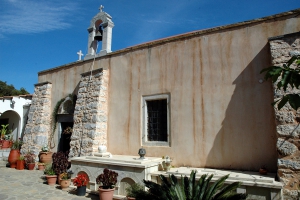
The monastery of the Virgin Mary «of the hollow stone» (Greek: Panagia Koufis Petras) is dedicated to the Annunciation. It is located west of Kremasta Monastery and at a short distance from Neapolis.
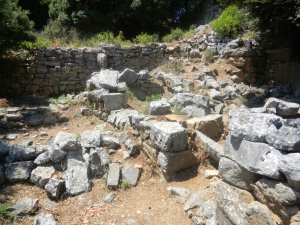
Ancient Dreros (or Driros) was built on the Mount Kadistos, next to the current church of St. Anthony, 2km northeast of Neapolis town. The town was inhabited by Eteocretans and Dorians (who arrived in Crete in 1100BC) and flourished in the Classical - Hellenistic Period.
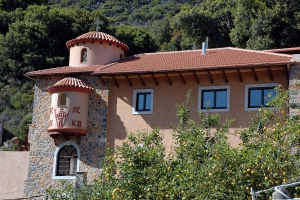
The Monastery of Kremasti or Kremasta is located south of Neapolis town, on the road connecting the town to the village Vrisses, at a position overlooking Neapolis. It is built with fort architecture on a steep wooded hillside of Mount Kavalaras and gives the impression that it’s hanging, a phenomenon to which the monastery owes its name (Kremasti means hanging).
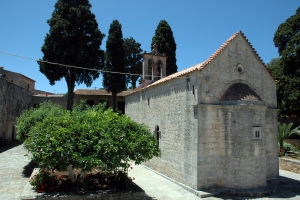
The Monastery of the Holy Trinity in Areti is located next to the village Karydi (close to Neapolis) in a dry and isolated area of Mirabello province. Along with the neighboring Kardamoutsa monastery, they were the most important monasteries of the area (This area has the most monasteries than any other place in Crete).
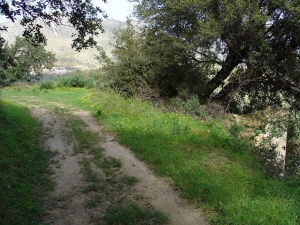
Paschaligo is a small grove located 1.5 km southwest of Neapolis town, on the northern slopes of Mt Kavalaras. The existence of the forest is related to the history of the region, which was named after the Venetian feudal lord Fillipo Pasqualigo, who lived in a tower that was built here.
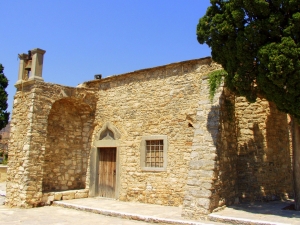
The large cemeterial church of Neapolis is a double-aisled church dedicated to Christ the Savior and All Saints. The church bears frescoes of the 14th century in relatively good condition. The existence of tanks suggests that the site was used as a small monastery.
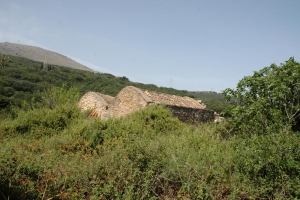
Monastery of Fraro or St. Anthony' in Simeti is located 1km west of Neapolis. It is a ruined Franciscan convent dedicated to San Antonio. The name comes from the Latin word Frari, as the meaning Franciscan friars were called.
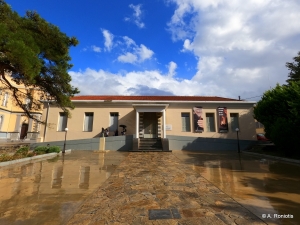
The Folklore and Historical Museum of Neapolis is housed since 2016 in the building of the First Gymnasium of Neapolis and is managed by the Cultural Folklore Society of Ano Mirabello. Its exhibition is composed of relics of the cultural tradition from the province of Mirabello that depict the everyday life after the 19th century.
- 1
- 2

























































































